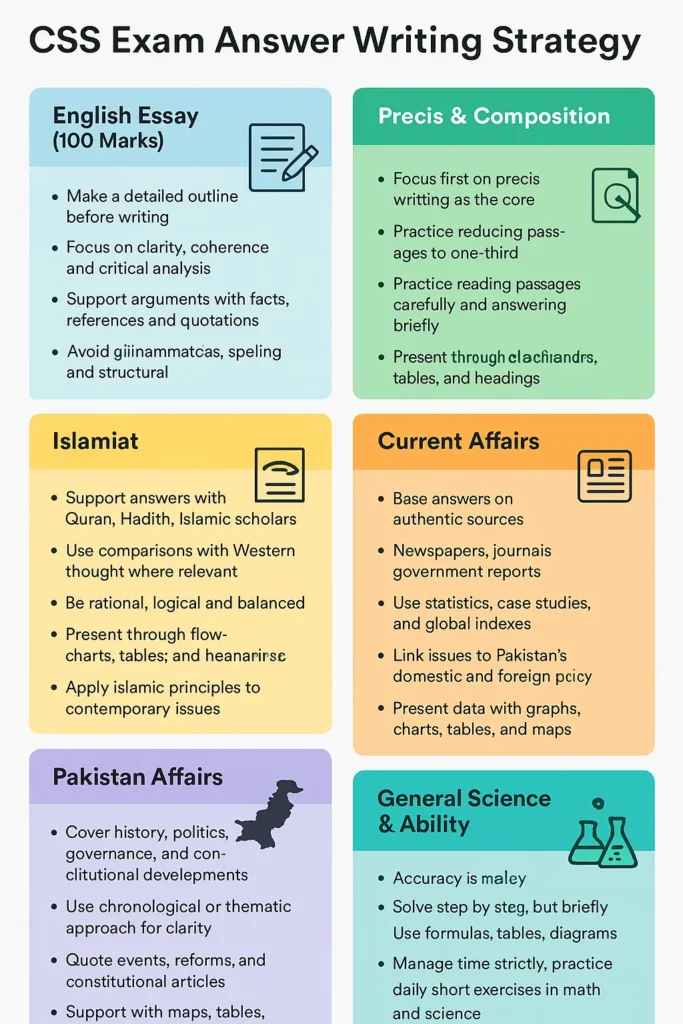CSS Paper Attempting Techniques: Expert Strategies to Maximize Your Marks
Introduction
Introduction
Success in the CSS exam isn’t just about knowledge—it’s about how effectively you attempt each paper. Each subject has a unique nature, and understanding the right approach is crucial for maximizing your marks. To make your answers stand out, consider using visual aids like graphs, tables, flowcharts, and maps. These tools not only help clarify your points but also impress the examiner, making your answers more engaging and organized.
This article offers subject-specific strategies, general tips, and expert techniques to help CSS aspirants optimize their exam attempts and maximize marks across different papers.
1. General Paper Attempting Tips
When attempting any CSS paper, following these general tips will ensure you stay on track and improve your chances of scoring higher marks:
- Read the Entire Paper First: Always start by reading all the questions carefully. Identify easier questions first, and plan your approach accordingly. For detailed information on the CSS syllabus, refer to the official CSS Syllabus to understand the subject breakdown.
- Time Management: Allocate your time based on the marks and complexity of each question. Use a timer to avoid spending too much time on any one question.
- Answer Easy Questions First: This helps you secure quick marks and boosts your confidence as you go along.
- Underline Keywords: When reading the question, underline key terms and concepts. This helps you focus on what the examiner is specifically asking.
- Plan Answers Visually: Whenever possible, use diagrams, flowcharts, or mind maps. Visuals not only clarify your points but also make your answers stand out.
2. Subject-Specific Attempting Techniques
Each CSS paper has its own unique requirements. Below are specific techniques for each subject that will help you approach them more effectively:
A. Essay Paper
- Plan Your Essay: Begin with an outline that includes your introduction, main arguments, supporting examples, and a strong conclusion.
- Stick to the Topic: Avoid irrelevant digressions and focus on answering the exact question.
- Credibility: Use relevant examples, quotes, scholarly references, and data to support your arguments.
- Organization: Visual aids like flowcharts or diagrams can help illustrate your arguments and create a logical flow throughout your essay.
- Balance: Present both perspectives (for/against, pros/cons) before concluding with your stance.
B. Islamiat / Ethics
- Support with References: Always quote Quranic verses, Hadith, and respected scholars to strengthen your argument.
- Comparative Approach: Include views from Western philosophers for a well-rounded perspective.
- Ethical Dilemmas: Use real-world examples and logical reasoning to provide practical solutions.
- Presentation: Use flowcharts or tables for decision-making models to make your answers clearer.
- Be Rational and Balanced: Approach issues objectively and avoid emotional bias toward one sect.
C. Pakistan Affairs
- Constitutional Framework: Make sure to refer to the Constitution and relevant governance structures in Pakistan.
- Historical Backing: Always link your answers to historical events and important movements.
- Organization: Structure your answer chronologically or thematically to provide clear context.
- Visual Aids: Use maps for geographical or administrative divisions and tables to summarize key reforms or events.
D. Current Affairs
- Use Authentic Sources: Cite newspapers, think-tank reports, and government data. Avoid generalizations and rely on specific statistics or case studies.
- Evidence-based: Link your arguments to hard data, international rankings, or case studies.
- Visual Presentation: Use graphs and charts to present economic, political, or social issues effectively.
- Critical Approach: Avoid generic answers. Always link your arguments to real-world developments and the context of Pakistan.
E. General Science & Ability
- Math Questions: Focus on accuracy and clarity. Solve step by step, and avoid unnecessary derivations. Use formulas, diagrams, or tables where needed.
- Science Questions: Each question has 4 parts (A-D), each worth 5 marks. Answer concisely—use diagrams or flowcharts and don’t overwrite.
- General Tips:
- Attempt easy questions first.
- Use the elimination technique in MCQs.
- Manage time strictly—don’t spend too long on small-mark questions.
F. Optional Subjects
- Conceptual Clarity: Show your understanding by using relevant theories, examples, and case studies.
- Use Comparisons: Where appropriate, compare international examples or policies to demonstrate broader knowledge.
- Social Sciences: Use flowcharts or thematic diagrams to organize complex ideas and arguments.
- Science Subjects: Use formulas, processes, and labeled diagrams to provide clear and structured answers.
- Attempt questions according to subject nature (conceptual, analytical, or factual).
Show conceptual clarity with relevant theories, examples, and case studies.
Use comparisons (e.g., with international examples, policies, or historical precedents).
For social sciences: Flowcharts and thematic diagrams.
For science subjects: Formulas, processes, and labeled diagrams.
Extra Tip: Prepare at least 2 “high-scoring” optional subjects with notes, examples, and ready-made diagrams to save time.
Additional Tip: Relate global events to Pakistan’s foreign policy (Afghanistan, Kashmir, FATF, CPEC).
Always attempt from a theoretical perspective, even for current issues.
Apply theories: Realism, Liberalism, Constructivism, Marxism.
Structure: Theory → Application to Issue → Policy Suggestion.
Comparative analysis: Discuss how different states approach the same issue.
Use tables/flowcharts to show cause-effect relationships (e.g., US–China rivalry → Global trade impact).
Quote IR scholars, UN reports, international treaties.

3. Presentation & Answering Tips
The presentation of your answers plays a crucial role in how the examiner perceives your work. Here’s how to ensure that your answers are presented well:
- Write Clearly and Neatly: Your handwriting should be legible. The examiner should not struggle to read your answer.
- Use Headings and Bullet Points: This helps organize your answer and makes it easier for the examiner to follow.
- Visual Aids: Where applicable, use diagrams, tables, and charts to enhance the clarity of your answer.
- Cite References: Quote from Quran, Constitution, newspapers, or IR theories where relevant to add authority to your answer.
- Leave Space for Additional Points: This allows you to add extra points or corrections if needed, which can increase your score.
4. Common Mistakes to Avoid
Avoid these common mistakes during your exam to ensure you don’t lose valuable marks:
- Spending Too Much Time on One Question: Prioritize questions based on marks and difficulty. Don’t get stuck on one question for too long.
- Writing Irrelevant or Unstructured Answers: Always stick to the question asked. Avoid going off-topic and structure your answers logically.
- Forgetting Examples, References, or Visual Aids: Using real-life examples and references strengthens your argument. Don’t leave out visual aids if they make your answer clearer.
- Poor Handwriting or Disorganized Presentation: Neat handwriting and organized presentation are crucial. Use headings, bullet points, and avoid clutter.
- Not Leaving Time for Revision: Always save a few minutes at the end for revising and correcting any mistakes.
5. Conclusion
Each CSS paper should be approached according to its unique nature. Here’s a quick summary of how to tailor your answers:
- Islamiat: Use Quran, Hadith, and Western references to explain ethical reasoning.
- Pakistan Affairs: Include constitutional references and historical context.
- Current Affairs: Base answers on newspapers, reports, and data.
- IR: Analyze questions using theoretical frameworks.
- Optional Subjects: Present conceptual clarity and examples.
Visual aids like graphs, tables, flowcharts, and maps, when used appropriately, will enhance your answers and make them more engaging for the examiner. By following these strategies, you’ll not only improve the clarity of your responses but also increase your chances of maximizing your marks in the CSS exam.
